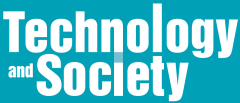The effect of technologies on our lives might be less about technology and more about the priorities and parameters we set.



The effect of technologies on our lives might be less about technology and more about the priorities and parameters we set.

A new archive of material added a new historical dimension to our discussions of cybernetics at the 2016 Norbert Wiener Conference in Australia.

Graeme Clark is the inventor of the cochlear implant. He was the dinner Keynote Speaker at the 2016 Conference on… Read More

A bot (short for robot) performs highly repetitive tasks by automatically gathering or posting information based on a set of… Read More